How To Combine History And Lifestyle Into A Blog Post
Themeisle content is free. When you purchase through referral links on our site, we earn a commission. Learn More
Blogging may only be a little over 20 years old, but the nature of blogs has undergone incredible transformations during those years. In this article, we'll explore the history of blogging, from the first recognized blog to the crowded blogosphere of 2020.
The early history of blogging
Most experts agree that the first blog was Links.net, created in 1994 by then-student Justin Hall as a place to publish his writing. The site consisted entirely of brief posts, each one sharing a link and some of his thoughts on the content within. This compilation of links included links to websites he liked, as well as his own work.

Others quickly followed in Hall's footsteps, creating their own sites to share their personal lives and thoughts. With the term "blog" not invented yet, these sites were referred to as "Online Diaries" or even "Personal Pages". In 1997, the term "weblog" was coined by Jorn Barger of the influential Robot Wisdom blog to describe these sites.
Many of those early blogs were created by programmers and focused on highly technical subjects, but in 1998 Jonathan Dube became the first journalist to blog an event. His blog chronicled Hurricane Bonnie for The Charlotte Observer, as pictured below:

1998 also saw the creation of Open Diary, a blogging platform that allowed members of the community to comment on each other's writing. This was the first of many tools that made blogging accessible to regular people, regardless of their programming experience.
How different blogging platforms began and died
Just as the cumbersome, code-heavy blogs of the late '90s began to give way to more accessible solutions, in 1999 the word "weblog" was dropped in favor of a simpler term: "blog" by Peter Merholz. This year also saw the advent of three new blogging platforms: Xanga, LiveJournal, and Blogger. Xanga, a site that focused more on the social side of blogging (similar to MySpace), boasted 300,000 users at its peak but faded out of the blogging scene entirely.
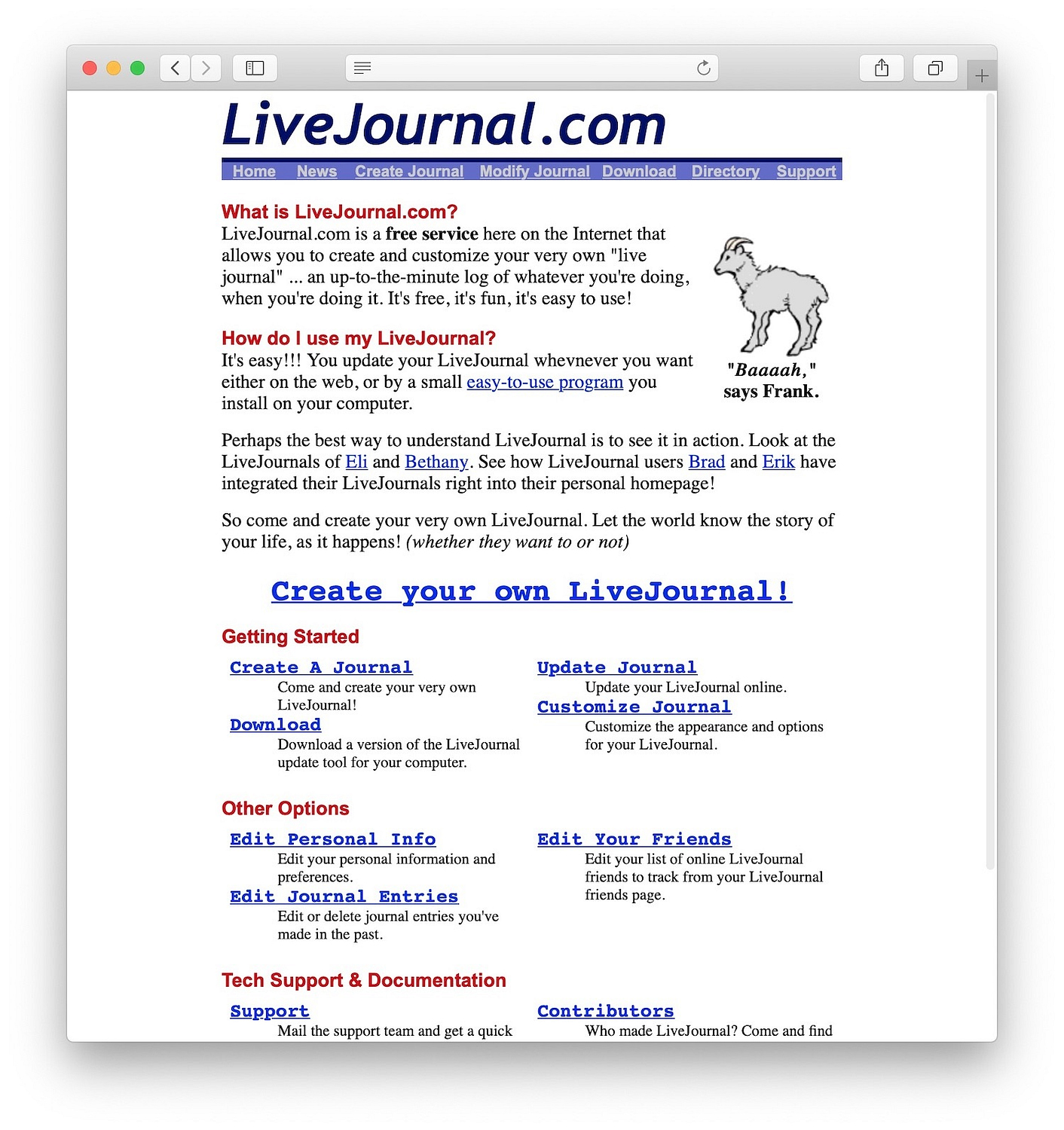
LiveJournal started as a website where Brad Fitzpatrick could keep in touch with his high school friends, and quickly grew into a place where all kinds of people could record their thoughts and develop communities. LiveJournal sustained popularity as a blogging platform into the mid-2000s, but gradually transformed from a blogging site where all were welcome into one of Russia's primary social media platforms.
Blogger, on the other hand, began its life as a commercial blogging service created by Pyra Labs. The platform would go on to be purchased by Google in 2003 and made freely available to the world. This move pushed not just Blogger, but also the entire concept of blogging, into the mainstream.

The early 2000s
As blogging became more popular, tools appeared to help people curate their blog reading list or market their own blogs. 2002 was a particularly big year for the blogosphere. People also started to monetize their blogs with sites like BlogAds, a precursor to Google AdSense.

The first-ever blog search engine, Technorati, launched that November.
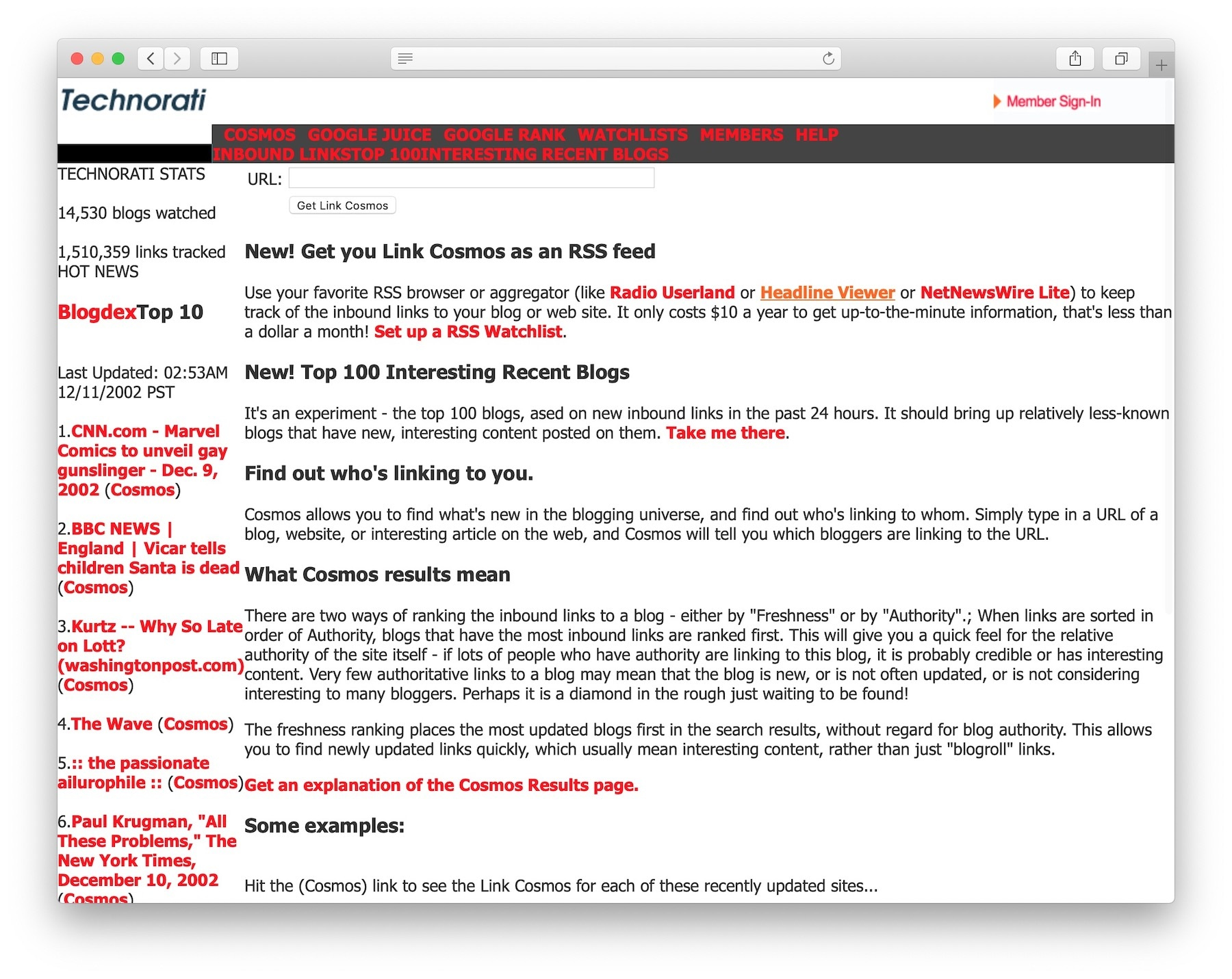
Many popular blogs also launched in this year, including Gizmodo and Gawker, some of the earliest companies to use blogging itself as their primary business model. Check out the original version of Gizmodo below:
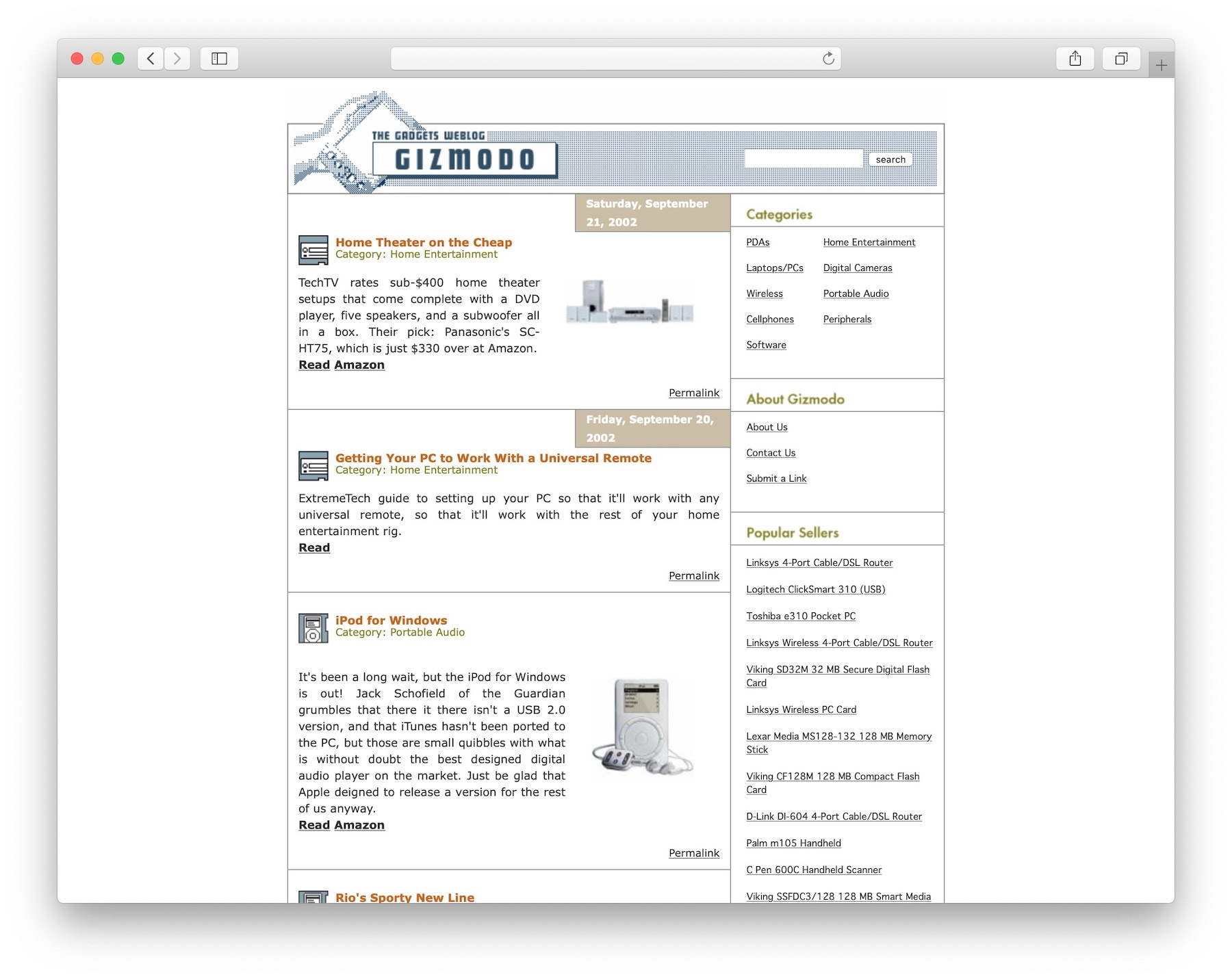
Heather Armstrong became the first person to get fired for talking about her job on her blog in February 2002, putting her blog Dooce in the spotlight of many conversations about internet privacy. "Dooced" even became a verb, meaning "fired for blogging".
2002 was a big year for blogging, but 2003 turned out to be even bigger. Google purchased Blogger and introduced AdSense, making it possible for anyone to monetize their blog without needing to join a special network like BlogAds.
2003 also saw the birth of two new brand-new blogging services that would further alter the blogosphere: TypePad, a commercial blogging platform that hosts blogs for major multimedia companies like the BBC, and WordPress, the open-source platform we use for Themeisle and our sister sites. These platforms made it easy for companies to create their own fully customized blogs and sell advertising directly to companies for improved profits.
Check out Blogger vs WordPress pros and cons to help you choose the right platform for you.

In 2005, Garrett Graff became the first blogger in the history of blogging to be granted a press pass for the White House. This, along with the birth of Huffington Post in the same year (see the original site below), brought blogging into the political realm and gave the medium a new level of legitimacy as a media source.
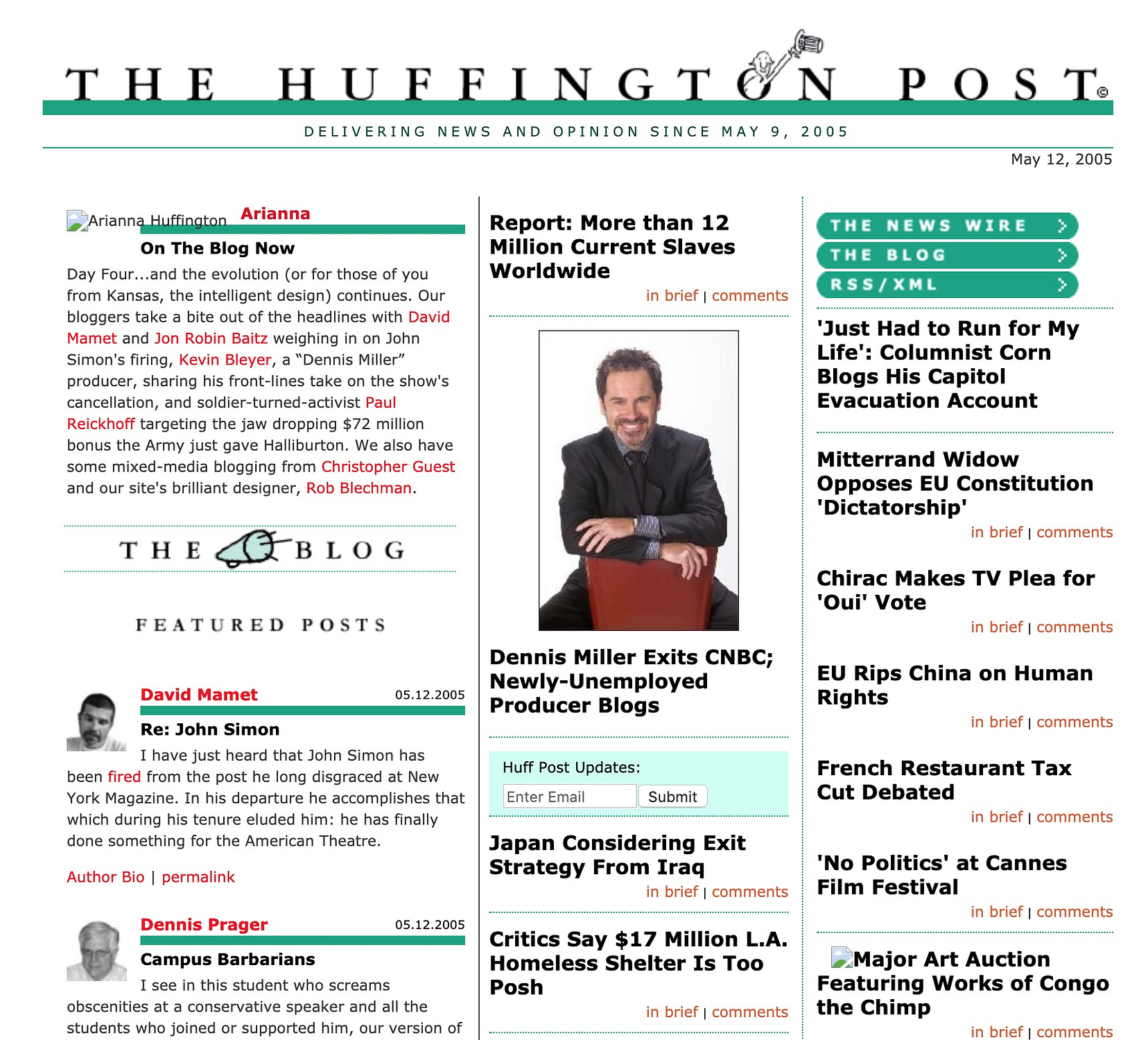
The rise of vlogging
With the rise of blogging came a whole new style of blog: video blogs, or vlogs. The first vlog entry was created in 2000 by Adam Kontras. It's a short video that doesn't seem like much, but it was the beginning of a new form of content, and even more, a new industry:
See the first vlog:
Like the pre-2000s blogs, vlogs grew slowly but steadily until 2005 when an innovative platform, YouTube, made the medium accessible to the masses. Like Blogger, YouTube was bought by Google in 2006.

Today YouTube is home to much more than vlogs, but vlogging is still at its core, with the top creators making millions of dollars per year. Forbes even publishes an annual list of top YouTube stars.
A brief history of blog design
The rise of vlogging was only one sign of a major shift in internet usage: as internet connections grew faster and more stable, images and video became more prominent. Images and design also became gradually more important to blogging success. Early blogs consisted almost entirely of text that stretched across the entire page, with only the occasional small image. You can see this early design aesthetic if you take another look at that screenshot of Links.net:

The design aspect of blogs has evolved and grown more important with each new iteration of the concept. Early platforms like LiveJournal and Blogger offered limited but simple customization. This allowed people with no coding experience to create unique sites. Popular LiveJournal layouts also introduced some elements of design that are still common in WordPress themes, like the centered text pictured below:

From potterpuffs.livejournal.com
Many blog designs during this era of the history of blogging also used elements like images of notebook rings or even just beige coloring to simulate the feeling of reading a paper journal, like the one pictured below:

When WordPress launched its open source code in 2003, design possibilities exploded. Developers could use the WordPress technology to build themes, and people with no previous web design experience could customize those templates and build their sites with ease.
Since then, premium WordPress themes have become an industry to themselves. ThemeIsle joined this wave of companies in 2012, with a strong desire to make WordPress themes more fun for both site owners and new visitors. Our first theme, CreativeMag, was released in 2012:
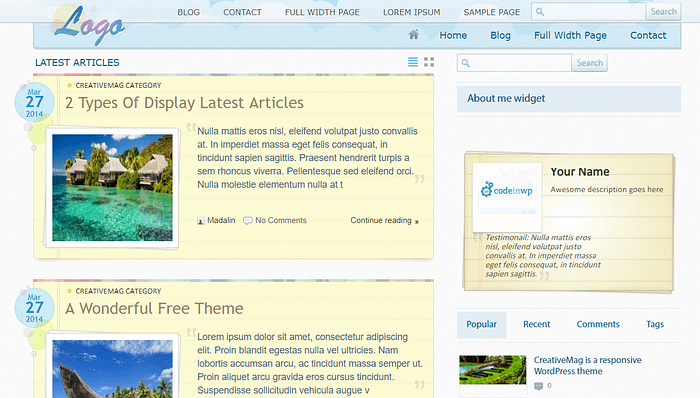
The CreativeMag theme showcases several popular design elements from this era in the history of blogging, including possibly the most enduring element of modern blog design, the sidebar. Like many older themes, it uses beige coloring to evoke the feeling of reading a journal. The sidebar features an image of lined paper to strengthen this association.
The rise of responsive design
No article about the history of blogging would be complete without a mention of the mobile revolution. Mobile traffic was responsible for more than 50% of all internet traffic in 2018. But websites created in the early-to-mid 2000s don't look great when you view them with a mobile phone.
Some companies created separate mobile sites designed for phones, but this was costly and impractical. The better answer, it seemed, was responsive design. Responsive design, or design that alters itself to fit the user's screen, has existed in some form since 2001 but rose to popularity in 2015, when Google announced that sites would be penalized if they weren't mobile-friendly.
Today, responsive design is built into most WordPress themes, including all the themes you'll find here at Themeisle.
A quick history of blog SEO
Another important aspect of the history of blogging is the development of search engine optimization, commonly referred to as SEO. The creation of Google in 1998 changed the internet forever. The site quickly gained popularity, and enterprising individuals soon realized that they could use excessive keywords to make an impact on the search engines. Blogs, as sites that are frequently updated and have a heavy focus on text content, were a natural way for businesses to add large numbers of these keywords to their sites.
In the early days of SEO, all you needed was to shove the correct keywords into your sentences as many times as possible, and the search engines would reward you. High-quality websites often shared the front page of Google with keyword-stuffers and other SEO spammers.
Fortunately, Google noticed those spammers early on and began a long series of algorithm updates designed to punish sleazy SEO tactics and reward authentic, high-quality content. Today's SEO is rooted in a combination of human psychology and an understanding of how Google and other search engines categorize content.
All in all, the changes to SEO reward high-quality blogs, making blogs an even more instrumental part of marketing. Companies who blog receive 55% more visitors to their website. Those visitors are also higher quality; SEO leads get a 14.6% close rate, whereas outbound leads have a much lower closing rate of 1.7%.
Blogging in recent years (2012-2018)
Blogging continued to grow at a steady pace, but there wasn't true innovation in the blogosphere until the creation of Medium in 2012. Throughout its lifetime, Medium has made waves by introducing new ways to pay creators. They introduced a subscription model, and in 2017 replaced it with a partnership program. Today, Medium is home to thousands of blogs with varying levels of success, and they even employ some writers directly.

LinkedIn introduced its own blogging platform, Pulse, for select users in 2013. Over time Pulse was rolled out to a growing number of users, becoming available to all in 2015.
While some creators use Medium, LinkedIn Pulse, and the outcropping of similar sites as their primary blog, many use them as secondary and tertiary posting grounds. This brings content hosted on low-traffic domains to large new audiences.
Social media works with blogs in a similarly symbiotic fashion. Most bloggers today have some kind of social media marketing strategy. They share every blog post on a plethora of social media platforms. Vloggers use similar marketing tactics, and many also run blogs as well.
Blogging today in 2020 and in the future
The history of blogging is far from over. According to different estimates, there are millions of blogs live today. Plus, blogs are especially important to marketing: 85% of B2C companies and 91% of B2B companies use blogs or other forms of content marketing.
What is the next stage in the history of blogging? I can't guess what the next innovative blogging platform will be, but I do have some ideas. As popular social media sites reduce organic reach and become pay-to-play markets, businesses will possibly revert to relying on SEO as their primary online marketing tool. This can make blogs become even more popular in the coming months and years.
What do you think is the next stage in the history of blogging? Let us know in the comments section below!
Free guide
5 Essential Tips to Speed Up
Your WordPress Site
Reduce your loading time by even 50-80%
just by following simple tips.
Download free guide
How To Combine History And Lifestyle Into A Blog Post
Source: https://themeisle.com/blog/history-of-blogging/
Posted by: harrisonourch1959.blogspot.com

0 Response to "How To Combine History And Lifestyle Into A Blog Post"
Post a Comment